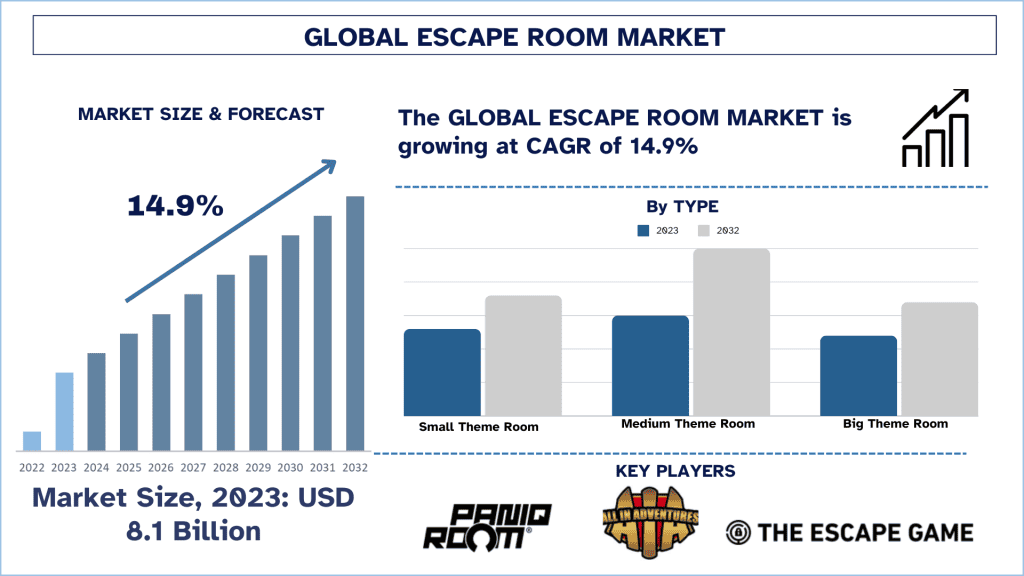
The Escape Room Market was valued at approximately ~USD 8.1 billion in 2023 and is expected to grow at a strong CAGR of around 14.9% during the forecast period (2024-2032)
Technology is a key factor in the development of the escape room market, as the innovations improve the quality and uniqueness of the experience. They are revolutionizing the escape room business by providing better, interactive, and customizable games. With the progressive development of technologies, it is possible to suggest that modern Escape Room owners can actively use these tools to expand the potential of their activities and saturate their creations with new elements that will intrigue consumers and expand their circle of enthusiasts. Here’s a detailed look at how technological advancements are shaping this industry:
Virtual Reality (VR): This improves upon the conventional escape room concept to incorporate entirely virtual environments that cannot be accomplished physically. With this technology, potential applications for creating engaging environments are virtually limitless – from space exploration to ancient civilizations. Another benefit of VR escape rooms is that players do not require physical involvement, meaning they can join from anywhere, increasing market reach.
Augmented Reality (AR): Augmented Reality blends informative signs, riddles, and operational facets with reality or the physical surroundings. : This technology improves immersion by incorporating actual and digital objects within the game space so that individuals can click on objects that exist as well as objects only in the game. AR can be implemented in such a way that they adapts to players’ decisions or in order to offer timely and precise hints to the players.
Interactive Props and Gadgets: Escape room scenarios of contemporary designs make use of sophisticated mechanisms including computer-generated doors and locks, motion detectors, or touch-based interfaces. These interactivities can respond to players’ inputs, not just as actions that bring about changes in the puzzles but as actions that make the puzzles even more challenging and interesting to solve. For instance, electronic locks may use the players to solve numerical puzzles in order to unlock, the motion sensors could cause an event or reveal a clue.
RFID Technology: The organization of the escape room and tracking of players’ movement/interactions is done through the use of radio-frequency identification (RFID) tags. RFID-equipped items can be used to open locks, set off specific game events, or respond accordingly to players’ controls. This technology helps to organize and improve the game by providing the automation of particular elements within the game.
Access sample report (including graphs, charts, and figures): https://univdatos.com/reports/escape-room-market?popup=report-enquiry
Projection Mapping: Projection mapping is the technique of displaying images and animations on a surface to produce an impressive and transforming background. This technology is useful in changing the walls and objects in the escape room by converting them into an enjoyable display that makes the scenes fun as well as exciting to fit the escape room’s theme.
Enhanced Audio Systems: To enhance the physical environment and make it more seemly, there are integrated audio systems with surround and spatial audio. Extra sounds which include quality sound effects, voice-overs, other sounds, and even noises of the environment also add to the experience as well as the reality of the whole escape room.
Smartphone Integration: Most escape rooms incorporate such features as smartphone apps for delivering clues, timeline tracking, and a way for the players to communicate with the game masters. Features like powerups and clues can be delivered through the application and it can also include features like timers and other virtual features which complement the gameplay. Certain rooms also give the ability to players to influence events that transpire in the game through their phones.
Gamification and Data Analytics: Extra or ornamental features like points, levels, leader boards, badges, etc are adopted to support and reinforce the players. Operators use data analytics solutions to gain a better understanding of the players and their play process, based on which, escape room concepts and experiences can be improved.
Click here to view the Report Description & TOC: https://univdatos.com/reports/escape-room-market
Remote and Hybrid Escape Rooms: Technological advancement has pushed up the emergence of other forms of escape rooms, including remote and hybrid digital/physical forms. They can join the game from different locations using webcams and other online solutions while also engaging the physical or virtual game attributes. This type of model only strengthens the concept’s possibility of experiencing escape rooms and opens up new pathways of interaction.
AI and Machine Learning: AI and machine learning are currently being used in order to find how to implement intelligent puzzles and responsive game environments that would change with players’ actions and choices. AI can be used to create unique events for players, give hints specific to the player, and analyze the gameplay to improve it.
Recent developments in the market are:
In June 2024, Chesterfield Escape Rooms launched a sequel to the popular Rob the Bank game.
In May 2024, U.K.-based Great Escape Game, in Sheffield city center, unveiled a new immersive bar experience for spook-seekers and socialites.
In November 2021, Escape Hunt proposed the acquisition of Boom Battle Bars and a name change to XP Factory with the goal of geographic expansion.
In September 2021, the Beverly Group, joined forces with Superdough, the company behind Breakout Escape Rooms and Hauntu Horror House, and launched LIИDA a unique virtual experience specially developed for One Equine property.
With such applications, these approaches will hopefully create a niche for the global escape room market in the future years. However, the process of achieving full embrace of new strategies faces some barriers. Restrictions include safety considerations related to the entertainment industry in which they operate. The emergence and growth through new and innovative products characterizing the entertainment industry incontestably alter the market. This trajectory is expected to further rise in the present day and age to inspire people all around the world.
Conclusion
However, the future of escape room is very promising, despite the so mentioned challenges. Indeed, a new day is of in the continued growth and expansion of the new entertainment industry. It can be concluded that these activities are changing the very method of managing the industry, introducing incredible diversification to the population all over the world. According to the UnivDatos the growing popularity of escape rooms and rising consumer interest in exceptional engaging & enticing entertainment across the globe will drive the global scenario of the escape room market.
Contact Us:
UnivDatos
Email: contact@univdatos.com
Contact no: +1 978 7330253
Website: www.univdatos.com















